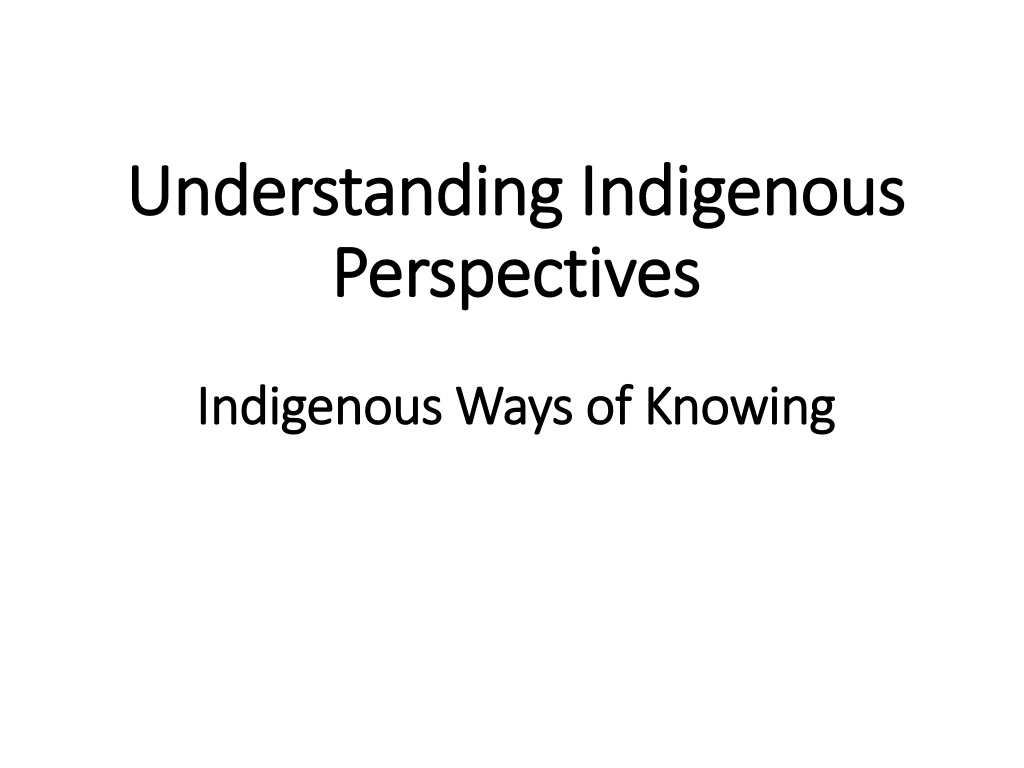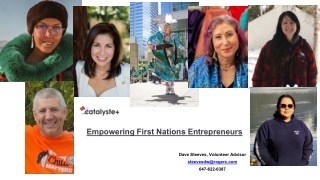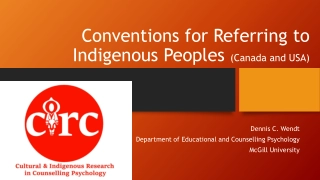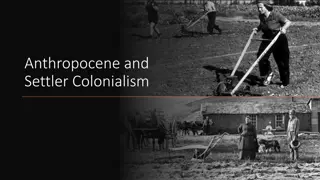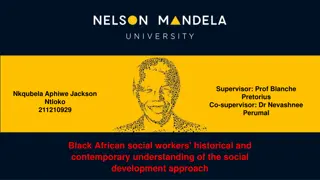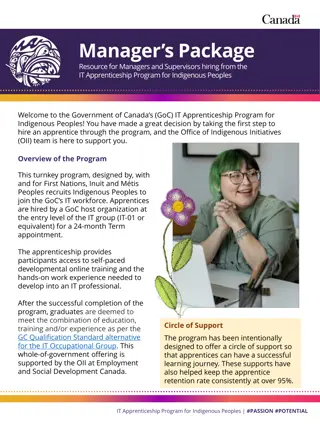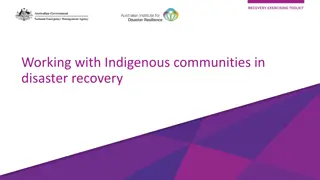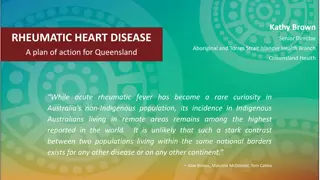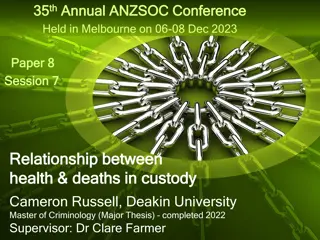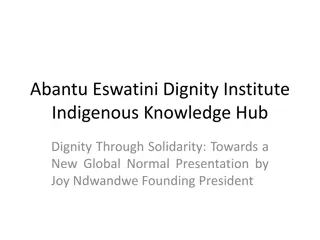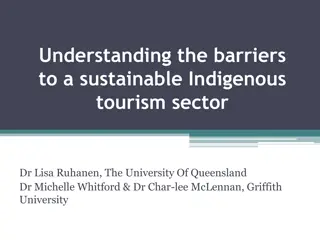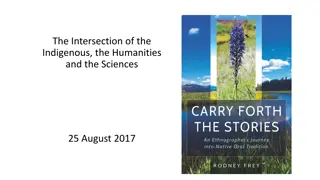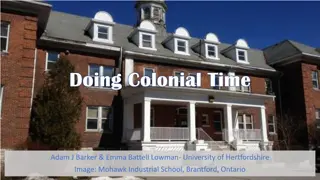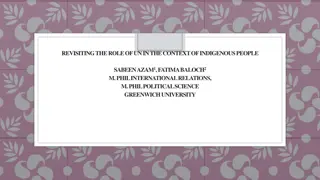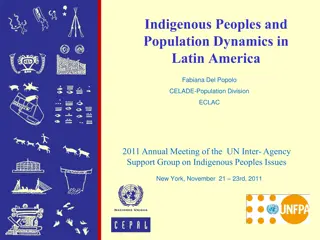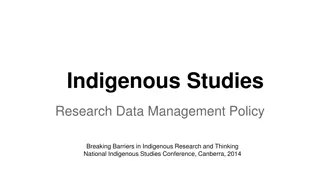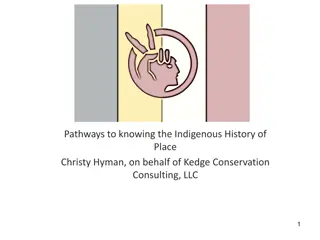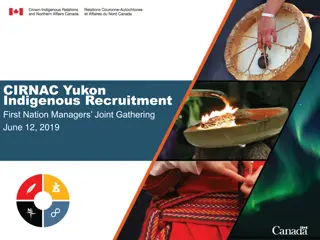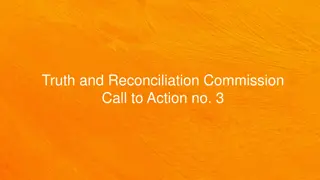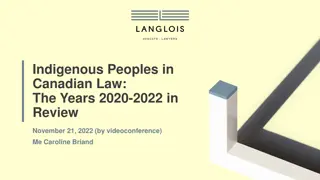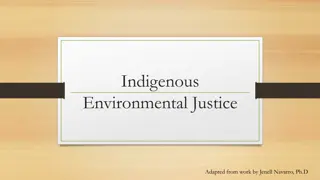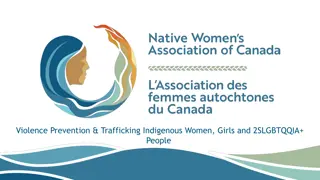Exploring Indigenous Knowledge in Education
Delve into Indigenous ways of knowing, understanding, and learning, emphasizing the importance of integrating traditional Indigenous pedagogies in education. Learn about the characteristics, sources, and values of Indigenous knowledge, and explore the intersection of Indigenous knowledge with Western science. Reflect on your own sources of knowledge and values through thought-provoking questions.
Download Presentation

Please find below an Image/Link to download the presentation.
The content on the website is provided AS IS for your information and personal use only. It may not be sold, licensed, or shared on other websites without obtaining consent from the author. Download presentation by click this link. If you encounter any issues during the download, it is possible that the publisher has removed the file from their server.
E N D
Presentation Transcript
Understanding Indigenous Understanding Indigenous Perspectives Perspectives Indigenous Ways of Knowing Indigenous Ways of Knowing
Welcome to Indigenous Ways of Knowing <<Add welcoming video Jean-Paul>>
All students deserve a quality education, one that benefits from the contributions of the original peoples on the land they now call home. Indigenous knowledges are living ways of making sense of the world embedded in community practices, rituals and relationships. This module explores Indigenous ways of knowing towards enriching education.
Learning outcomes By the end of this module, you will be able to: Recognize traditional Indigenous pedagogies and ontological understandings Realize that knowledges are subjective and appreciate their relationship to worldviews. Elaborate on specific characteristics of Indigenous knowledge. Contextualize the sources of Indigenous knowledge
Reflecting questions How do you know what you know? Where do you get your knowledge from? Are some sources more trustworthy than others? How do you determine what sources of knowledge are credible? What values underlie your opinions?
Indigenous ways of knowing: topics You will explore the following topics in this module: 1. What is Indigenous knowledge? 2. Characteristics of Indigenous knowledge 3. Sources of Indigenous knowledge 4. Indigenous axiology: values and ethics 5. Indigenous knowledge and Western science side by side 6. Indigenous knowledge and learning: Reimagining education 7. Suggested activities]
What is Indigenous knowledge? Indigenous knowledge definitions can be problematic because they often use the dominant knowledge system (Western knowledge) as a frame of reference. In this module, Indigenous knowledge is described rather than defined. There are sources and characteristics that are shared among diverse Indigenous peoples but a hesitance to define it in one limiting way.
What is Indigenous Knowledge? Indigenous knowledge comprises the complex set of technologies developed and sustained by Indigenous civilizations. Often oral and symbolic, it is transmitted through the structure of Indigenous languages and passed on to the next generation through modeling, practice, and animation, rather than through the written word. Dr. Marie Battiste, 2002 p.2
What is Indigenous Knowledge? Indigenous knowledge is embedded in community practices, rituals, and relationships. As a living knowledge, it is holistic, contextual, and relational.
Characteristics of Indigenous knowledge Indigenous knowledge has at least five characteristics: 1.Indigenous knowledge is personal 2.Indigenous knowledge is orally transmitted 3.Indigenous knowledge is experiential 4.Indigenous knowledge is holistic 5.Indigenous knowledge is narrative Source: Castellano, M. B. (2000). Updating Aboriginal traditions of knowledge. In G. J. S. Dei, B. L. Hall, & D. G. Rosenburg (Eds.), Indigenous knowledges in global contexts. Toronto, Ontario, Canada: University of Toronto Press.
Characteristics of Indigenous knowledge 1.Indigenous knowledge is personal Indigenous knowledge relies on every person s integrity and perceptiveness .There is no one person who has the truth . The intersection of different voices and perceptions is what produces knowledge. With multiple perceptions at the core, Indigenous knowledge actualizes itself in context. Thus, Indigenous knowledge is highly dynamic. Source: Castellano, M. B. (2000). Updating Aboriginal traditions of knowledge. In G. J. S. Dei, B. L. Hall, & D. G. Rosenburg (Eds.), Indigenous knowledges in global contexts. Toronto, Ontario, Canada: University of Toronto Press.
Characteristics of Indigenous knowledge 2. Indigenous knowledge is orally transmitted Oral tradition is not a precursor to literate traditions. They are simply different ways for knowledge- keeping. Through oral tradition, Indigenous knowledge is a collective enterprise. Telling stories multiple times, creates more comprehensive narratives that are reflective of the actual context where they are told. Sources: Castellano, M. B. (2000). Updating Aboriginal traditions of knowledge. In G. J. S. Dei, B. L. Hall, & D. G. Rosenburg (Eds.), Indigenous knowledges in global contexts. Toronto, Ontario, Canada: University of Toronto Press. http://Indigenousfoundations.arts.ubc.ca/home/culture/oral-traditions.html
Oral traditions form the foundation of Aboriginal societies, connecting speaker and listener in communal experience and uniting past and present in memory. (Basso, 1996) Source: Basso, Keith. Wisdom Sits in Places: Landscape and Language among the Western Apache. Albuquerque: University of New Mexico Press, 1996
Listen to this narration of the Four Direction Teachings in the Ojibwe wheel: http://www.fourdirectionsteachings.com/audio/Ojib_01M_intro.mp3 http://www.fourdirectionsteachings.com/audio/Ojib_02M_Centre.mp3 http://www.fourdirectionsteachings.com/audio/Ojib_03M-East.mp3 http://www.fourdirectionsteachings.com/audio/Ojib_04M-South.mp3 http://www.fourdirectionsteachings.com/audio/Ojib_05M-West.mp3 http://www.fourdirectionsteachings.com/audio/Ojib_06M_North.mp3 Explore the Four Directions Teachings celebrating Indigenous oral traditions by honoring the process of listening with intent as each elder or traditional teacher shares a teaching from their perspective on the richness and value of cultural traditions from their nation.
Characteristics of Indigenous knowledge 3. Indigenous knowledge is experiential The land is alive. The only way to know that is to be on the land. The senses can know more deeply and concretely than knowledge gained through reading or being told. Tell a kid not to touch a stove and you may have to say it 30 times but if the same child touches the stove they know pretty quickly how hot it is. What many Anishinaabek used to do is have children build the fire with them. They saw how things started cool and became progressively hotter and learned through this process to be careful around a stove. Sources: Castellano, M. B. (2000). Updating Aboriginal traditions of knowledge. In G. J. S. Dei, B. L. Hall, & D. G. Rosenburg (Eds.), Indigenous knowledges in global contexts. Toronto, Ontario, Canada: University of Toronto Press.
An elder is asked, What do you mean by the land is alive . The elder says, Come with me and I ll show you. After four or five days of walking through the forest and digging roots and doing work, the student says, Are you ever going to tell me what is meant by the land is alive ? The elder replies, I see you need a few more days out here.
Characteristics of Indigenous knowledge 4. Indigenous knowledge is holistic Indigenous knowledge uses all senses to get at that inner space that brings together internal and external worlds, the physical and the spiritual. Ceremonies carry knowledge in a holistic way. Fire, water, air and land are all present in ceremonies. Power comes from bringing complementary energies together. Sources: Castellano, M. B. (2000). Updating Aboriginal traditions of knowledge. In G. J. S. Dei, B. L. Hall, & D. G. Rosenburg (Eds.), Indigenous knowledges in global contexts. Toronto, Ontario, Canada: University of Toronto Press.
The pipe is very sacred to First Nations people. In the past, it was used to open negotiations between different nations as a way for good talk to take place. The pipe is in two pieces and travels this way. Only in ceremony are the male and female parts brought together. The pipe becomes whole and prayers offered are sacred. As everyone touches the pipe, the circle is brought together. Prayer passes from inner worlds to the outer worlds via the smoke that enters the body and leaves the body.
Characteristics of Indigenous knowledge 5. Indigenous knowledge is narrative As you have seen already, Indigenous knowledge is conveyed using narrative. Stories contain the knowledge that is needed to live in a good way, transmitting vital teachings without preaching. Knowledge happens and actualizes itself in the sharing. Narratives use metaphors guiding moral choice and self- examination Sources: Castellano, M. B. (2000). Updating Aboriginal traditions of knowledge. In G. J. S. Dei, B. L. Hall, & D. G. Rosenburg (Eds.), Indigenous knowledges in global contexts. Toronto, Ontario, Canada: University of Toronto Press.
Traditional stories are rich embodiments of traditional knowledge. Here is an example from the Montagnais. the Legends of Pekuakamiulnuatsh From the shores of Lac St Jean, these traditional legends of the Pekuakamiulnuatsh - the Montagnais of Lac Saint-Jean - reflect a journey back in time when humans and animals spoke the same language. They share the lessons taught by an ancient culture and tap into our basic need for myth, crossing the boundaries of age, gender, ethnicity, and time. These lessons are as powerful now as they were 10 thousand years ago. Source: Originally broadcasted on Ideas on CBC Radio One. Accessed on July 20 from: http://www.cbc.ca/aboriginal/2009/04/legends-project-5.html
Sources of indigenous knowledge According to Marlene Brant Castellano (2000) Indigenous knowledges evolve from three sources: 1. Traditional knowledge 2. Empirical knowledge 3. Revealed knowledge Source: Castellano, M. B. (2000). Updating Aboriginal traditions of knowledge. In G. J. S. Dei, B. L. Hall, & D. G. Rosenburg (Eds.), Indigenous knowledges in global contexts. Toronto, Ontario, Canada: University of Toronto Press.
Sources of indigenous knowledge 1. Traditional knowledge Indigenous peoples knowledge, skills and practices that are developed, sustained and carried forward from generation to generation. Traditional knowledge is a living chronicle of the origins, trajectories and achievements of Indigenous peoples. It is a record of Indigenous Peoples allegiance to their ancestral lands. Source: Castellano, M. B. (2000). Updating Aboriginal traditions of knowledge. In G. J. S. Dei, B. L. Hall, & D. G. Rosenburg (Eds.), Indigenous knowledges in global contexts. Toronto, Ontario, Canada: University of Toronto Press.
Sources of indigenous knowledge 2. Empirical knowledge Indigenous peoples knowledge develops through the careful observation of the connections and relationships of living beings with one another and their environment. Empirical Indigenous knowledge is ecological. It is a cumulative body of knowledge, practice and belief evolving by adaptive processes. Empirical knowledge is the convergence of different vantage points, accumulated over time. Source: Castellano, M. B. (2000). Updating Aboriginal traditions of knowledge. In G. J. S. Dei, B. L. Hall, & D. G. Rosenburg (Eds.), Indigenous knowledges in global contexts. Toronto, Ontario, Canada: University of Toronto Press.
Indigenous Knowledge and the land Indigenous knowledge is rooted in relationship with the land: Land touches every aspect of life: conceptual and spiritual views; securing food, shelter and clothing; cycles of economic activities including the division of labour; forms of social organization such as recreational and ceremonial events; and systems of governance and management . (RCAP, 1996, 2.2.4.3.2) http://www.collectionscanada.gc.ca/webarchives/200711 15053257/http://www.ainc- inac.gc.ca/ch/rcap/sg/sgmm_e.html
Empirical Indigenous knowledge contributes to the understanding of our times. Watch the following documentary on Inuit knowledge and climate change. Nunavut-based director Zacharias Kunuk and researcher and filmmaker Dr. Ian Mauro teamed up with Inuit communities to document their knowledge and experience regarding climate change. This documentary takes the viewer on the land with elders and hunters to explore the social and ecological impacts of a warming Arctic. http://www.isuma.tv/en/inuit-knowledge-and-climate-change
Sources of Indigenous knowledge 3. Revealed knowledge Indigenous knowledge is sometimes revealed through dreams, visions and intuitions. Sometimes knowledge is received as a gift at a moment of need; sometimes it manifests itself as a sense that the time is right (Castellano, 2000 p.24) Source: Castellano, M. B. (2000). Updating Aboriginal traditions of knowledge. In G. J. S. Dei, B. L. Hall, & D. G. Rosenburg (Eds.), Indigenous knowledges in global contexts. Toronto, Ontario, Canada: University of Toronto Press.
In Cree knowledge, animals have dual forms of existence, the physical and the transcendental. Their physical attributes have evolved through time, but the spirit form remains the same. Humans connect with the transcendental spirit form of the animal, not the corporeal. Cree who want to be successful hunters seek knowledge from animals by establishing a relationship with their spiritual beings in their dream. Source: Healing through Art: Ritualized Space and Cree Identity, Nadia Ferrara, McGill-Queen's Native and Northern Series, Montreal, McGill-Queens University Press, 2004.
Indigenous Axiology: Values and Ethics Indigenous axiology refers to the values, ethics, and principles that are embedded in Indigenous knowledge. The way one comes to know is as important as what one comes to know. In other words, the process is as important as the product.
The nations of the Haudenosaunee believe that we borrow the earth from our children s children and it is our duty to protect it and the culture for future generations. All decisions made now are made with the future generations who will inherit the earth in mind. Source:http://www.haudenosauneeconfederacy.com/culture.html
The Ojibwe Seven Grandfathers Teachings (Seven Sacred Teachings) is another example of axiology in practice. Dbaadendiziwin - Humility Aakwa'ode'ewin - Bravery Gwekwaadziwin - Honesty Nbwaakaawin - Wisdom Debwewin - Truth Mnaadendimowin - Respect Zaagidwin - Love Source: http://ojibweresources.weebly.com/ojibwe-teachings--the-7-grandfathers.html
Indigenous knowledge and Western science side by side The modern Western Worldview developed in tandem with the expansion of European colonial empires. With colonial imperialism came an emphasis on the centrality and superiority of European theories and ideas also known as Eurocentrism. Eurocentrism has used Western science to discredit and delegitimise and marginalize Indigenous knowledges. This process has also been described as Cognitive imperialism (Battiste, 1986) Here we present characteristics of both systems side by side to illustrate the different emphases, assumptions and outcomes of knowing within each system. For the following discussion, refer to diagram 1 from: http://www.ankn.uaf.edu/curriculum/Articles/BarnhardtKawagley/In digenous_Knowledge.html
Indigenous knowledge and Western science side by side Western science is a Subset of Euro-Western Culture. Indigenous knowledge is culture. Indigenous culture is knowledge.
Indigenous knowledge and Western science side by side Western science focuses exclusively on the the physical/tangible world. The physical world is isolated from the spiritual, intangible sacred world. For Indigenous knowledge the physical and the sacred realms are not separate.
Indigenous knowledge and Western science side by side For Western science human beings are separate and distinct from the world around them. For Indigenous knowledge human beings are connected to all other living beings. Indigenous knowledge is non-anthropocentric.
Indigenous knowledge and Western science side by side Western science method lies on the principles of measurability, verifiability, predictability and generalizability. Focusing on objects as discrete entities, Western knowledge proffers universal solutions to problems that are of human concern. For Indigenous knowledge there are no discrete objects of study. Knowledge is holistic, communal and highly contextual. Following natural laws, Indigenous knowledge does not aim at producing anthropocentric theories or solutions, but at observing relationships between elements within a system.
Indigenous knowledge and Western science side by side Western science proffers a fragmented, linear and hierarchical understanding of the world. It reduces experience to mechanical and mathematical relationships. Indigenous knowledge revers and respects all life enacting the principles of reciprocity and interdependence, balance and wholeness, inner and outer harmony.
Indigenous knowledge and Western science side by side Western science serves exploitative systems of social interaction. It operates in an elitist and highly competitive system where only few achieve the status to carry knowledge forward. Indigenous knowledge is inclusive, cooperative and peaceful. It nourishes the learning spirit as a foundation for sustainable ways of being.
Indigenous knowledge and Western science side by side As you can see, we have made generalizations about both Indigenous knowledge and Western scientific knowledge. Remember that the boundaries between the two are not so hard and fast and that both kinds of knowledge can exhibit different aspects. Most importantly, there are instances where Indigenous knowledge and Western science overlap.
Indigenous knowledge and Western science side by side Listen to this panel discussion on Indigenous Knowledge and Western Science. Indigenous academics Leroy Little Bear, Dr. Gregory Cajete and Rob Cardinal examine how to create rich learning experiences by infusing traditional Indigenous knowledge with Western physics and astronomy. https://www.youtube.com/watch?v=JeNnOZTk440
Indigenous knowledge and learning: Reimagining education Dominant education systems endorse and advance Western science, technology and educational methods. In doing so, they perpetuate a worldview where the world of humans is separated from nature, and knowledge severed from the realm of the sacred. But our ongoing existence with the world makes such separation unjustifiable and unsustainable. Indigenous knowledge is a living force that brings humanity in relation with the rest of nature in narratives that are open and inclusive of all living things.
Indigenous knowledge and learning: Reimagining education Let s get inspired by First Nations Principles of Learning and Dr. Martin Brokenleg's presentation of the Circle of Courage at the Truth and Reconciliation Commission hearings: https://www.youtube.com/watch?v=0PgrfCVCt_A&sn s=tw&utm_content=buffer82a22&utm_medium=soci al&utm_source=twitter.com&utm_campaign=buffer
Indigenous knowledge and learning: Reimagining education Get inspired by Indigenous ways of living sustainably. Read A spiritual relationship to the land under Activity 1. Teaching and living sustainably: http://www.unesco.org/education/tlsf/mods/theme_c/mod11 .html?panel=4#top
Suggested Activities Share with your fellow learners this living representation of First Nations Holistic Life Long Learning model created by the former Canada Council on Learning and the Aboriginal Learning Centre: http://education.chiefs-of- ontario.org/upload/documents/resources/lifelong- learning/ccl_lifelonglearning_model_fn.pdf Host a conversation about this model. Discuss who the nurturing guides are and whether there are more learning rings in one s life.
Suggested Activities: Talking Circle Create an atmosphere of trust and mutual learning by trying talking circle. The Talking Circle format is a helpful teaching strategy familiar to many Indigenous cultures. Everyone in a Talking Circle learns to listen and respect the views of others. A feather, stick, rock or other earth-based object can be held by the speaker to symbolize when it is their turn to speak. When one learner is holding the object, others have the responsibility to listen.
Suggested Activities Talking Circle Discuss a topic using the protocols of a talking circle. Teachers have used talking circle as a first activity on a Monday to ask students how they are feeling. What happened on the weekend? What are you looking forward to this week? Or culminating activity on a Friday. What did you learn this week that really interested you? What do you hope to do this weekend?
Resources and further learning What matters in Indigenous Education : Implementing a Vision Committed to Holism, Diversity and Engagement by Pamela Rose Toulouse http://peopleforeducation.ca/measuring-what- matters/wp-content/uploads/2016/04/P4E-MWM-What- Matters-in-Indigenous-Education.pdf Equity Matters by Jean-Paul Restoule http://www.ideas- idees.ca/blog/everything-alive-and-everyone-related- Indigenous-knowing-and-inclusive-education
